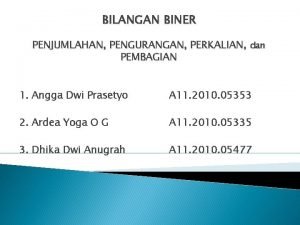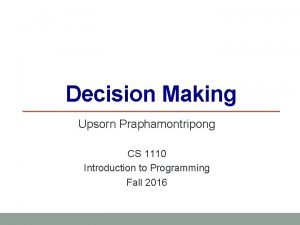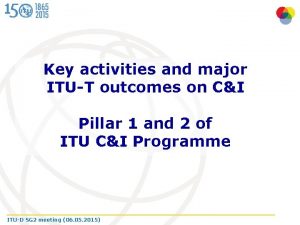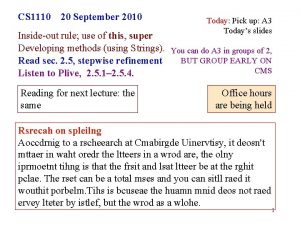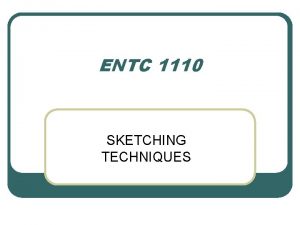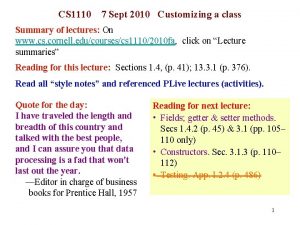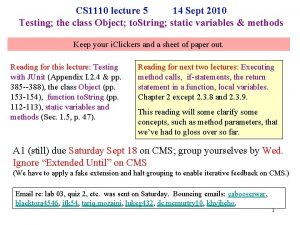CS 1110 21 Sept 2010 Today Pick up










- Slides: 10

CS 1110 21 Sept 2010 Today: Pick up: A 3 Today’s slides Inside-out rule; use of this, super Developing methods (using Strings). You can do A 3 in groups of 2, BUT GROUP EARLY ON Read sec. 2. 5, stepwise refinement CMS Listen to Plive, 2. 5. 1– 2. 5. 4. Reading for next lecture: the same Office hours are being held Rsrecah on spleilng Aoccdrnig to a rscheearch at Cmabirgde Uinervtisy, it deosn't mttaer in waht oredr the ltteers in a wrod are, the olny iprmoetnt tihng is that the frsit and lsat ltteer be at the rghit pclae. The rset can be a total mses and you can sitll raed it wouthit porbelm. Tihs is bcuseae the huamn mnid deos not raed ervey lteter by istlef, but the wrod as a wlohe. 1

A 1 A 3: Adding functionality to A 1 • Keeping class invariant true • Use already-written functions • Boolean expressions • Use of null and testing for it • Use of static variables Due Wednesday, 29 September 2

Remember frame boxes and figuring out variable references? The inside-out rule (see p. 83) Code in a construct can reference any of the names declared or defined in that construct, as well as names that appear in enclosing constructs. (If a name is declared twice, the closer one prevails. ) Person. Pop a 0 name Person get. Name. And. Pop() { return name + Person. Pop; } a 1 name Person get. Name. And. Pop() { return name + Person. Pop; } File drawer for class Person 3

Method parameters participate in the inside-out rule: remember the frame. a 0 name a 1 Person set. Name(String n) { name= n; } Parameter n would be found in the frame for the method call. name Doesn’t work right Person set. Name(String name) { name= name; } Parameter name “blocks” the reference to the field name. 4

A solution: this and super Within an object, this evaluates to the name of the object. In folder a 0, this refers to a 0 name In folder a 1, this refers to a 1 Person. Pop a 1 Person set. Name(String name) { this. name= name; } name Person set. Name(String name) { this. name= name; } File drawer for class Person 5

About super Within a subclass object, super refers to the partition above the one that contains super. a 1 Object method equals() method to. String() Elephant to. String() { … } Because of the keyword super, this calls to. String in the Object partition. other. Method { … … super. to. String() … } 6

Strings are (important) objects that come with useful methods. String s= "abc d"; Note the “index (number) from 0” scheme: 01234 abc d DO NOT USE == TO TEST STRING EQUALITY! Text pp. 175– 181 discusses Strings Look in CD Program. Live Look at API specs for String s. length() is 5 (number of chars) s. char. At(2) is 'c' (char at index 2) s. substring(2, 4) is "c " (NOT "c d") s. substring(2) is "c d" " bcd ". trim() is "bcd" (trim beginning and ending blanks) s. index. Of(s 1) –index or position of first occurrence of s 1 in s (-1 if none) s == t tests whether s and t contain the name of the same object, not whether the objects contain the same string. Use s. equals(t) 7

Principles and strategies embodied in stepwise refinement Develop algorithm step by step, using principles and strategies embodied in “stepwise refinement” or “top-down programming. READ Sec. 2. 5 and Plive p. 2 -5. • Take small steps. Do a little at a time • Refine. Replace an English statement (what to do) by a sequence of statements to do it (how to do it). • Refine. Introduce a local variable —but only with a reason • Compile often • Intersperse programming and testing • Write a method specification —before writing its body • Separate concerns: focus on one issue at a time • Mañana principle: next slide 8

Principles and strategies • Mañana Principle. During programming, you may see the need for a new method. A good way to proceed in many cases is to: 1. Write the specification of the method. 2. Write just enough of the body so that the program can be compiled and so that the method body does something reasonable, but no the complete task. So you put off completing this method until another time —mañana (tomorrow) —but you have a good spec for it. 3. Return to what you were doing and continue developing at that place, presumably writing a call on the method that was just “stubbed in”, as we say. 9

Anglicizing an Integer anglicize(1) is "one" anglicize(15) is "fifteen" anglicize(123) is "one hundred twenty three" anglicize(10570) is "ten thousand five hundred seventy" /** = the anglicization of n. Precondition: 0 < n < 1, 000 */ public static String anglicize(int n) { } We develop this function, in Dr. Java, using the principles and strategies of stepwise refinement (also called topdown programming). 10
